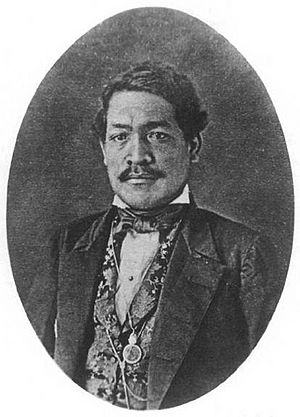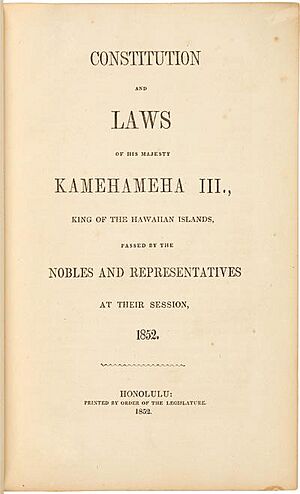1852 Constitution of the Hawaiian Kingdom facts for kids
The 1852 Constitution of the Hawaiian Kingdom was like a new rulebook for the government of Hawaii. King Kamehameha III created it, writing it in both English and Hawaiian. Its main goal was to update and add much more detail to the earlier 1840 Constitution. This new constitution made the Hawaiian government more democratic, similar to governments in the United States and Europe at the time.
Contents
King Kamehameha III: The Creator
The person who wrote the Hawaiian Constitution of 1852 was Kauikeaouli, better known as King Kamehameha III. He became king after his brother, King Kamehameha II. Kauikeaouli was also the son of Kamehameha I, a very famous Hawaiian king.
Kauikeaouli became king when he was just eleven years old. His mother, Ka'ahumanu, helped him rule during his younger years. This period of a young ruler being helped by an older, experienced person is called a "regency."
In 1840, King Kamehameha III introduced Hawaii's first constitution. This document created a government more like those in Western countries, with two groups of lawmakers. The 1852 constitution later improved upon this. King Kamehameha III was the first Hawaiian monarch to rule as a "constitutional monarch." This means he ruled according to a written constitution and respected the rights of his people, rather than having absolute power.
Why a New Constitution?
The 1840 constitution was Hawaii's first written set of laws. It was greatly influenced by Europeans and Americans living in Hawaii, especially by Protestant missionaries who arrived in 1820.
The 1840 constitution set up two groups of lawmakers: the House of Nobles and the House of Representatives. It also created a court system similar to the one in the United States. The king even served as the chief judge of the Supreme Court.
While the 1840 constitution did divide the government's power in a new way, it was very general. It didn't say much about how Hawaii would handle foreign countries. It also didn't clearly explain things like land rights or how communities should be organized.
Because of these missing details, King Kamehameha III and the Hawaiian Kingdom Legislature decided to revise the constitution. They chose three special commissioners for this big task. The King chose one, the House of Nobles chose another, and the House of Representatives chose the third. These commissioners worked hard and practically rewrote the entire constitution.
The new 1852 Constitution was much longer, with 106 sections. The old one only had 47. The 1852 version included a much clearer "Declaration of Rights." This helped explain the rights of the people, especially regarding land and community organization, which had been confusing before. The new constitution also declared that all adult men were free from forced labor.
It also changed the House of Nobles. Before, members inherited their positions. Now, the King appointed them for life. The new constitution also clearly spelled out the powers of the Legislative (lawmaking), Judicial (court system), and Executive (King and his helpers) branches of the Hawaiian government.
The 1852 Constitution: What It Included
The Constitution of 1852 guided the Hawaiian Kingdom from 1852 to 1864. It made the Hawaiian government much more open and democratic than the 1840 constitution. It also reduced the King's power in daily government matters.
The 1852 Constitution of the Kingdom of Hawaiʻi was organized into seven main parts:
- Declaration of Rights
- Form of Government
- Of the Executive Power (about the King, his helpers, and governors)
- Of the Legislative Power (about the House of Nobles and House of Representatives)
- Of the Judiciary (about the court system)
- General Provisions (other important rules)
- More Amending of the Constitution (how to change the constitution)
The "Declaration of Rights" clearly stated that the people of Hawaii were free. The "Form of Government" declared that Hawaii was a Constitutional Monarchy, meaning the King ruled under a constitution. The other sections explained the specific powers of the King, the lawmakers, and the courts. The "General Provisions" covered anything not mentioned elsewhere, and the final section explained how the constitution could be changed.
Changes in 1856
An important change to the 1852 constitution was suggested in 1855. It was officially approved on September 15, 1856. This change had eight parts. Its main purpose was to allow the lawmakers (the legislature) to meet every two years instead of every year.
One change allowed the King to close down the legislature for up to two years if there was a big disagreement. Another change removed the King's power to appoint the heads of government departments. He could still remove them and ask for information, but not appoint them. The amendment also changed how often government departments had to report their business. Now, reports were due at the start of each new financial year.
The biggest change was that the legislature would meet every two years, not annually. They would vote on how money would be spent every two years, based on past spending and future plans. Finally, the amendment clarified that members of the House of Nobles could resign from their positions. They would hold their seats for life unless they chose to resign.
From 1852 to 1864
The 1852 constitution was used during the reigns of King Kamehameha III and King Kamehameha IV. When King Kamehameha IV passed away in 1863, King Kamehameha V took the throne. However, he did not like the 1852 constitution. He felt it gave too much power to the people and wanted to bring more power back to the monarchy.
King Kamehameha V gathered a small group of leaders, including chiefs, regular citizens, and missionaries. He wanted them to create a new constitution. But the members of this meeting refused to approve his new ideas. So, King Kamehameha V simply ended the meeting and put his new constitution into effect himself.
The 1864 constitution gave more power to the King. It created a single group of lawmakers instead of two. It also limited freedom of the press and made the court system weaker. This new constitution also made it harder for poor people to vote or serve in the legislature by requiring them to own property. The 1864 constitution was shorter, with 80 articles compared to the 106 articles in the 1852 constitution.
Images for kids





